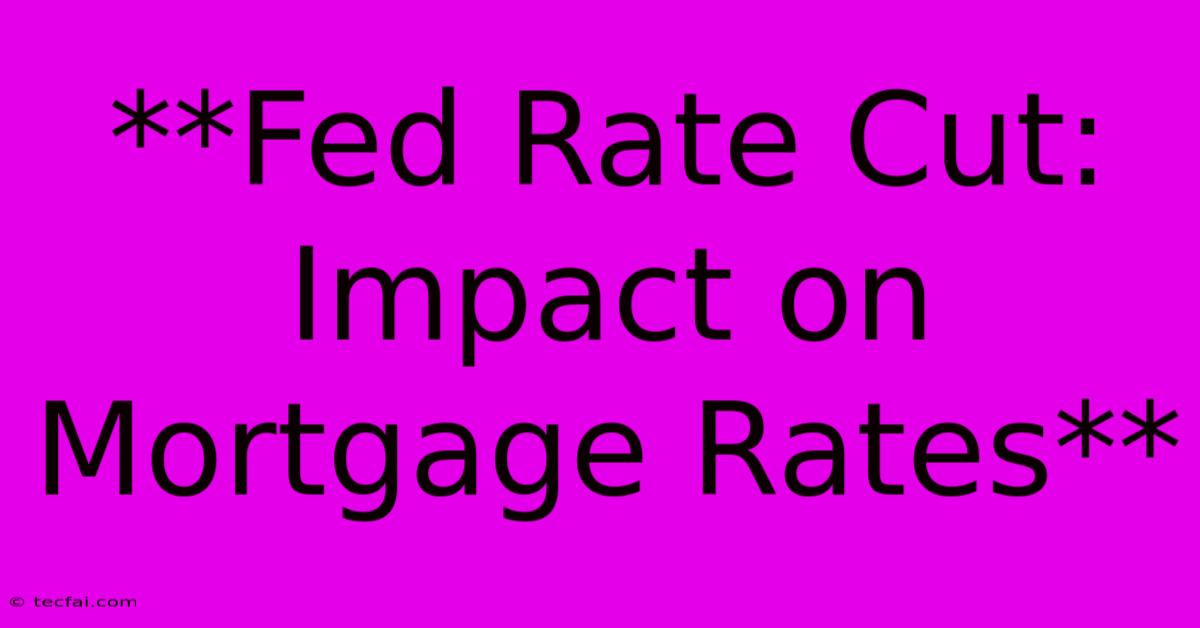**Fed Rate Cut: Impact On Mortgage Rates**

Discover more detailed and exciting information on our website. Click the link below to start your adventure: Visit Best Website tecfai.com. Don't miss out!
Table of Contents
Fed Rate Cut: Impact on Mortgage Rates
The Federal Reserve (Fed) plays a crucial role in influencing the economy by setting interest rates. When the Fed cuts interest rates, it often impacts mortgage rates, though not always directly or immediately. Understanding this complex relationship is essential for anyone considering taking out a mortgage or refinancing.
The Fed's Role in Interest Rates
The Fed's benchmark interest rate, known as the federal funds rate, is the rate at which banks lend money to each other overnight. This rate influences other interest rates in the economy, including mortgage rates.
When the Fed lowers the federal funds rate, it becomes cheaper for banks to borrow money. This can lead to:
- Lower borrowing costs for consumers: Banks may pass on these lower borrowing costs to consumers by offering lower interest rates on loans, including mortgages.
- Increased economic activity: Lower interest rates can encourage businesses to invest and consumers to spend, leading to economic growth.
How Fed Rate Cuts Impact Mortgage Rates
While a Fed rate cut doesn't guarantee a decrease in mortgage rates, it often creates a downward pressure on them. However, several factors influence mortgage rates beyond the Fed's actions:
- Inflation: High inflation can lead to higher mortgage rates as lenders demand higher returns to compensate for the declining value of money.
- Economic conditions: Economic uncertainty or fears of a recession can cause lenders to increase interest rates to protect themselves from potential losses.
- Investor demand: Mortgage rates are also influenced by investor demand for mortgage-backed securities. Strong demand can drive rates down, while weak demand can push them up.
What to Expect During a Fed Rate Cut
A Fed rate cut usually leads to a period of increased competition among mortgage lenders, as they try to attract borrowers with lower rates. This can result in:
- Lower mortgage rates for a short period: While rates may initially decline, they may not remain low for long, especially if other factors influence them in the opposite direction.
- More attractive refinancing opportunities: If you have an existing mortgage with a higher interest rate, a Fed rate cut may present an opportunity to refinance and save money.
Staying Informed about Mortgage Rate Trends
It's essential to stay informed about the current economic conditions and the Fed's monetary policy to understand the potential impact on mortgage rates. Keep an eye on:
- Federal Reserve announcements: The Fed publishes statements and meeting minutes that provide insights into their plans for interest rates.
- Mortgage rate trends: Several online resources track current mortgage rates and historical trends, allowing you to observe rate fluctuations.
- Financial news: Stay informed about economic news and analysis, as it can help you anticipate potential changes in mortgage rates.
Ultimately, understanding the relationship between Fed rate cuts and mortgage rates requires careful consideration of various economic factors. While a Fed rate cut can create an opportunity for lower mortgage rates, it's important to consult with a mortgage professional to determine the best course of action based on your individual financial situation.

Thank you for visiting our website wich cover about **Fed Rate Cut: Impact On Mortgage Rates**. We hope the information provided has been useful to you. Feel free to contact us if you have any questions or need further assistance. See you next time and dont miss to bookmark.
Featured Posts
-
Bo E Interest Rate Decision Live Updates
Nov 08, 2024
-
Barcelonas First Win Without Messi In 64 Years
Nov 08, 2024
-
Pressure Mounts On Scholz As German Government Stumbles
Nov 08, 2024
-
Livestream Chelsea Teen Noah Uefa Conference League
Nov 08, 2024
-
Fed Cuts Rates But Mortgage Rates Surge
Nov 08, 2024
